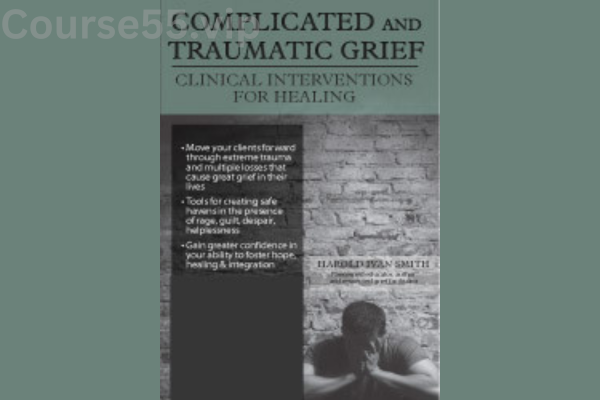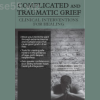Complicated and Traumatic Grief: Clinical Interventions for Healing By Harold Ivan Smith – PESI
$200.00 Original price was: $200.00.$23.10Current price is: $23.10.
Complicated and Traumatic Grief: Clinical Interventions for Healing by Harold Ivan Smith – Digital Download!

Complicated and Traumatic Grief: Clinical Interventions for Healing By Harold Ivan Smith – PESI
Overview

Exploring Complicated and Traumatic Grief: Clinical Strategies for Healing – A Review of Harold Ivan Smith’s Work
Grief is a universal human experience, yet it does not always follow a predictable path. In Complicated and Traumatic Grief: Clinical Interventions for Healing, Harold Ivan Smith provides an in-depth examination of grief’s more complex and prolonged forms, particularly when loss is traumatic. His work serves as a critical guide for clinicians, equipping them with assessment techniques, therapeutic approaches, and evidence-based interventions to support clients struggling with complicated grief.
By recognizing the symptoms of complicated grief and implementing effective interventions, mental health professionals can help individuals move beyond emotional paralysis and toward healing. Through clinical insights and case studies, Smith underscores the importance of tailored therapeutic strategies to address the psychological, emotional, and functional challenges associated with prolonged mourning.
Identifying the Distinct Nature of Complicated Grief
A foundational element of Smith’s work is his differentiation between typical and complicated grief. Unlike the natural mourning process, which gradually allows for emotional adjustment, complicated grief lingers, intensifies, and disrupts daily functioning. Individuals experiencing complicated grief often exhibit:
• Persistent Preoccupation with the Deceased – An overwhelming longing that hinders acceptance of the loss.
• Difficulty Adapting to Life Without the Loved One – Struggles with routine responsibilities and emotional engagement.
• Intense Emotional Distress – Prolonged sadness, guilt, or anger that interferes with daily life.
Smith supports these observations with empirical research, such as studies in the Journal of Affective Disorders, which reveal that individuals suffering from complicated grief report lower life satisfaction and higher emotional distress compared to those experiencing normal bereavement.
By recognizing these signs, clinicians can tailor their interventions to help individuals process their loss in a healthier and more adaptive way.
Assessing Complicated Grief: Essential Techniques
Accurate diagnosis is key to distinguishing complicated grief from typical bereavement or depression. Smith outlines several clinical assessment strategies designed to measure grief severity and provide a comprehensive understanding of an individual’s emotional state.
Key Assessment Methods:
• Structured Clinical Interviews – Guided conversations to explore grief intensity, emotional responses, and functional impairments.
• Self-Report Measures – Standardized tools such as the Inventory of Complicated Grief (ICG) to quantify yearning, emotional pain, and difficulty moving forward.
• Relational History Analysis – Understanding the bond between the deceased and the individual to contextualize their grief response.
• Symptom Severity Ratings – Evaluating the extent of distress and daily impairment to tailor therapeutic interventions.
By implementing these structured assessments, clinicians can develop personalized treatment plans that address both emotional and functional challenges.
Evidence-Based Therapeutic Approaches for Healing
Once a diagnosis is established, the next crucial step is choosing the appropriate intervention. Smith highlights several evidence-based treatments that have proven effective in helping clients navigate complicated grief.
Cognitive-Behavioral Approaches
Cognitive-Behavioral Therapy (CBT) is one of the most widely used interventions for complicated grief. It focuses on:
• Cognitive Restructuring – Helping individuals identify and challenge maladaptive thoughts about their loss.
• Behavioral Activation – Encouraging engagement in enjoyable activities to restore a sense of normalcy.
• Gradual Exposure to Triggers – Allowing clients to confront memories and reminders of the deceased in a supportive manner.
Narrative Therapy for Grief Integration
Smith also emphasizes the healing power of storytelling through Narrative Exposure Therapy. This approach involves repeatedly recounting the loss experience to help individuals integrate their grief into their personal history. Research has shown that clients who engage in narrative therapy often experience improved emotional processing and reduced grief intensity.
Therapeutic Techniques for Processing Grief:
• Cognitive Reframing – Guiding clients to reinterpret their loss in a way that promotes acceptance.
• Structured Reminiscence – Encouraging reflective storytelling to facilitate emotional release.
• Emotional Processing Exercises – Assisting clients in expressing and regulating their grief-related emotions.
By implementing these interventions, clinicians can support individuals in finding meaning beyond their pain and reconstructing a life without their loved one.
Restoration and Reconnection: The Path to Healing
Healing from grief is not just about processing loss—it is also about rebuilding life and rediscovering joy. Smith highlights the importance of restoring purpose and reconnecting with supportive relationships.
Strategies for Encouraging Restoration:
• Hobby and Interest Renewal – Encouraging clients to engage in activities that bring fulfillment.
• Rebuilding Social Connections – Facilitating interactions with family, friends, and support networks.
• Community Involvement – Promoting volunteer work and engagement in meaningful causes.
Research supports the idea that socially engaged individuals experience greater resilience and emotional stability in the wake of loss. By focusing on restoration-oriented activities, clinicians can help clients re-establish a fulfilling life beyond grief.
The Role of Group Therapy in Grief Recovery
Smith also advocates for group therapy as a powerful tool in grief treatment. By sharing experiences with others who understand their pain, individuals often feel less isolated and more emotionally supported.
Benefits of Group Therapy:
• Peer Support – Offering validation and encouragement from others facing similar challenges.
• Reduced Loneliness – Creating a sense of belonging and understanding.
• Collective Healing – Facilitating group discussions that normalize grief reactions.
Studies have shown that participants in grief support groups often experience reduced distress and greater emotional expression, highlighting the power of shared healing experiences.
Future Directions in Grief Therapy
Smith concludes his exploration of complicated grief by emphasizing the need for continued research and innovation in treatment approaches. Some of the emerging areas of study include:
• Combining Medication with Psychotherapy – Exploring how Selective Serotonin Reuptake Inhibitors (SSRIs) may complement grief-focused therapies.
• Culturally Adapted Interventions – Developing grief treatments tailored to diverse populations and belief systems.
• Long-Term Outcome Studies – Examining the effectiveness of grief interventions over extended periods.
As the field of grief therapy evolves, integrating scientific advancements with compassionate clinical practice will be essential in enhancing treatment effectiveness.
Final Thoughts: A Crucial Resource for Clinicians
Complicated and Traumatic Grief: Clinical Interventions for Healing by Harold Ivan Smith stands as a vital resource for mental health professionals. By providing comprehensive insights into grief assessment, evidence-based interventions, and long-term recovery strategies, Smith equips clinicians with the tools to guide clients through the complexities of mourning.
Through targeted therapy, restoration-focused activities, and group support, individuals suffering from complicated grief can move toward healing, regain emotional stability, and ultimately rediscover a meaningful life beyond their loss.
Frequently Asked Questions:
Business Model Innovation: We operate a group buying strategy, allowing participants to share costs and access popular courses at reduced prices. This model benefits individuals with limited financial resources, despite concerns from content creators about distribution methods.
Legal Considerations: The legality of our operations involves complex issues. Although we don’t have explicit permission from course creators to resell their content, there are no specific resale restrictions stated at the time of purchase. This ambiguity creates an opportunity for us to provide affordable educational resources.
Quality Control: We ensure that all course materials purchased are identical to those offered directly by the creators. However, it’s important to understand that we are not official providers. As such, our offerings do not include:
– Live coaching calls or sessions with the course author.
– Access to exclusive author-controlled groups or portals.
– Membership in private forums.
– Direct email support from the author or their team.
We aim to reduce the cost barrier in education by offering these courses independently, without the premium services available through official channels. We appreciate your understanding of our unique approach.
Be the first to review “Complicated and Traumatic Grief: Clinical Interventions for Healing By Harold Ivan Smith – PESI” Cancel reply
You must be logged in to post a review.

 Attachment Focused Therapy: Trauma Related Disorders in Children & Adolescents By Daniel Hughes - PESI
Attachment Focused Therapy: Trauma Related Disorders in Children & Adolescents By Daniel Hughes - PESI  Transgender & Gender Non-Binary (TGNB) Clients: Clinical Issues and Treatment Strategies By lore m dickey - PESI
Transgender & Gender Non-Binary (TGNB) Clients: Clinical Issues and Treatment Strategies By lore m dickey - PESI 















Reviews
There are no reviews yet.